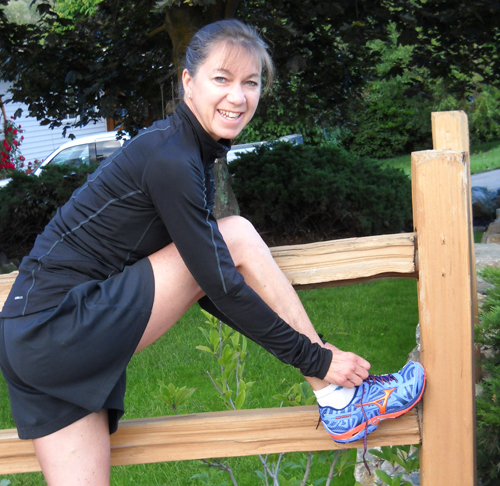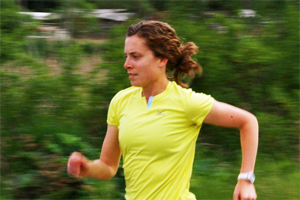
By: Nikki Reiter
So you just got in from your easy recovery jog – now it’s time to put back that recovery bar, or a perhaps indulge in a treat? It’s for recovery right? Don’t be too quick to devour. Yes, your body needs calories, but it’s important to know what kind, how much, and when, or you may be unknowingly packing on the pounds. As a runner or athlete, you know that every extra pound you carry costs time, wastes energy, stresses your joints, and affects your performance. To further discuss these ideas, I met with Dr. Sally Willis-Stewart, an instructor at the University of British Columbia Okanagan Campus in the school of Health and Exercise Sciences and leader of the Nutrition Education Center on campus. She is an Academic Affiliate with Dietitians of Canada and an award-winning instructor in the field of applied health and sports nutrition. Like many experts who advocate a healthy lifestyle, Dr. Willis-Stewart is also an avid (and quick!) runner.
What We Really Need
At the end of the day, we will lose weight based on the calorie balance we maintain. If you’re looking to reduce your weight, you have to consume fewer calories. Running can also facilitate weight loss, but it’s important to remind yourself that you’re fueling yourself to run. In order to improve as runners, we cannot begin our workout hungry and depleted of energy. This decreases the quality of the workout, which in turn limits our ability to improve our performance.
When it comes to what we should eat, “walk the perimeter of the grocery store (where fresh foods are found) and be cognitive of reading labels” says Dr. Willis-Stewart. By eating a variety of whole, natural foods, we can usually eliminate the need for supplements. Also, by choosing foods in their most natural state, you ensure the most nutrient density. If you must reach for items off the shelf, look closely at the ingredient list. Look for foods made with few ingredients, comprising of whole grains, low sugar, and low salt – and by all means keep foods with the word ‘hydrogenated’ (i.e. trans fats) to an absolute minimum. As for those ‘super foods’ (the ones that promise to deliver multiple health benefits) they will only get their chance to work wonders on you if you are first eating a basic, healthy diet.
When We Really Need It
It’s important to distinguish the needs of different runners and different workouts. Runners who engage in a short recovery run do not need to refuel in the same sense as a runner who just completed a glycogen-depleting 90 minute long run, or an intense session of intervals on the track. The seasoned runner who performs a light run will ideally time their run for before they have their snack. If you need a little extra boost pre-run, don’t follow that run with an extra snack unless it’s a tough workout where you need to replenish your body’s fuel stores. After an intense workout, it’s important to consume a post-workout snack that includes protein and carbohydrate (example: chocolate milk), and should be consumed within 30 minutes to optimize recovery for your next workout.
Dr. Willis-Stewart explains that “it’s important to refuel even if you’re trying to lose weight” and that planning is key. Bring your snack with you and plan your day so that you don’t reach for something unhealthy to get you through the afternoon. And since timing is also key, try to plan your snack around your workout. Ultimately, frequent eating will keep our blood sugar levels steady and eliminate those energy crashes we often feel. Ideally, we eat five ‘mini-meals’ a day, whereby we have breakfast, a snack, lunch, a snack, then dinner. To successfully adopt this pattern, meal portion sizes must be reduced from what is currently being consumed.
Pairing Running with Weight Loss
If you’re trying to lose weight while you’re running, your diet is just as important as the work you put into running. Remind yourself that you’re a runner, and that severely restricting your calories will lead to a rapid weight loss of not only fat, but also muscle. Additionally, it’s been shown that one can very quickly (and permanently!) slow their metabolic rate by restricting food. If you’re trying to improve your performance as a runner, this behaviour can be detrimental to your training program.
Often in an attempt to lose weight, we engage in diets that restrict certain foods. There is a danger associated with eliminating food groups. Protein, carbohydrates and fats are all important for our body’s development and maintenance. Protein helps rebuild muscle, carbohydrates replenish glycogen stores, and fat helps with satiety. There are always fads that lead us to believe that certain foods are bad for us. Granted, processed foods can definitely be eliminated from our diets. However, extreme diets that encourage eating the same foods or require extreme patterns of eating are not likely to be sustained. “When we eliminate certain foods, we lose certain groups of nutrients, which leads to a decreased function of our bodies” Dr. Willis-Stewart explains, and that “severely restricting yourself can lead feelings of deprivation: we eat not only for nourishment, but for comfort and cultural and social reasons as well.” Bottom line: your diet should fit in with your lifestyle.
Recipe: Sally’s Homemade Power Cookies
Mainstream granola bars, although often reached for in a bind, are considered ‘empty calories,’ that is, the energy source is often in the form of simple sugars and there are manufactured ingredients. For a snack that really packs a nutritional punch, try Sally’s Homemade Power Cookies (see recipe below).
Ingredients:
1 1/2 cups flour (mixture of whole wheat, spelt, kamut etc.)
1/2 cup brown sugar
1 cups oats
1/4 cups wheat germ, oat bran or quinoa puffs
1 cup high fiber cereal (muesli, fibre first, bran buds etc.)
2 tbsp. each of pumpkin, flax, sesame and sunflower seeds
3/4 cups dried fruit (mixture of raisins, apricots, dates, cranberries, pineapple etc.)
2 tbsp. protein powder (eg. soy, whey, skim milk powder)
1/3 cups med. shredded coconut
3/4 cups grated apple
1/2 cups chocolate chips
1 tsp. baking soda
1 tsp. cinnamon
1 grated rind of orange
1/2 cups non-hydrogenated margarine
1 egg
3 tbsp. honey or maple syrup
Directions:
- In a large bowl stir together dry ingredients
- Cut in the margarine until well blended
- Stir in the remaining wet ingredients and stir until well blended and moist
- Dough should be the consistency to roll or drop into small balls; you may need to add a bit more flour if too moist or a bit of plain yogurt or another egg if too dry, to get the right consistency
- Spoon by tablespoons onto a non stick cookie sheet
- Bake at 350 F degrees for 10 minutes
- Remove from sheet onto cooling rack immediately
- Enjoy and share them with a friend!
Happy Running!
***
 Nikki Reiter holds a master’s degree in biomechanics and is a Mizuno Running Brand Ambassador and the Women’s Cross Country Running Head Coach at the University of British Columbia Okanagan campus in Kelowna, BC. She is also the Laboratory Coordinator in the School of Health and Exercise Sciences at UBC Okanagan where she facilitates undergraduate laboratory learning.
Nikki Reiter holds a master’s degree in biomechanics and is a Mizuno Running Brand Ambassador and the Women’s Cross Country Running Head Coach at the University of British Columbia Okanagan campus in Kelowna, BC. She is also the Laboratory Coordinator in the School of Health and Exercise Sciences at UBC Okanagan where she facilitates undergraduate laboratory learning.





 Current Issue
Current Issue Previous Issue
Previous Issue Prior Release
Prior Release
